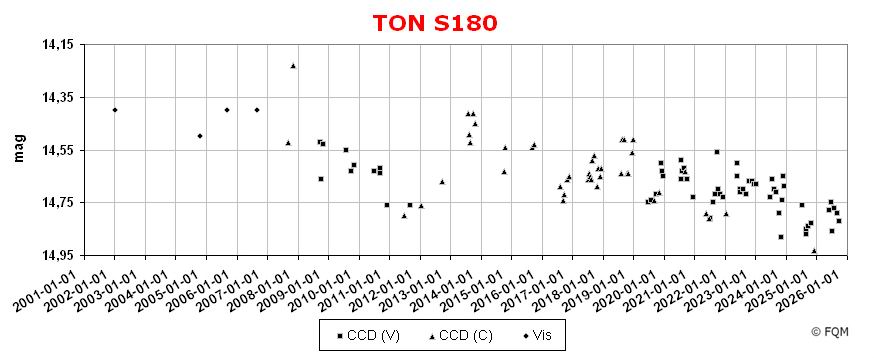
| Frankfurt Quasar Monitoring |
| TON S180 |
| Cross-Identifications | EUVE J0057-22.3, 2EUVE J0057-22.3, PHL 912 IRAS F00548-2238, 1WGA J0057-2222, RBS 139 RX J0057.2-2223, KUV 00549-2239, 0054-226 LEDA 87796, HE 0054-2239, QSO B0054-2239 |
| Equat. coordinates | RA 00 57 20.2 DE -22 22 56 (J2000) |
| Constellation | Cetus |
| Type (1) | QSO |
| Redshift |
z=0.062 |
| Distance (2) (3) | 247 Mpc |
| Total mag range (mv) (4) (5) | 14.35 - 14.8 |
| Catalog Magnitude (1) | 14.41 |
| Absolute Magnitude (1) | -23.3 MB |
| Light Travel-Time (2) | 0.784 × 109 yrs |

Comparison stars
| star | B | V | R |
| 1 | 13.30 | 12.74 | 12.42 |
| 2 | 14.35 | 13.80 | 13.47 |
| 3 | 14.79 | 14.14 | 13.75 |
| 4 | 15.31 | 14.62 | 14.21 |
| 5 | 16.44 | 15.29 | 14.68 |

| Quasar
TON S180 is located in southern Cetus, 2.8° SE of NGC 247 and
3.6° NE
of NGC 253, the "Sculptor Galaxy". The
designation TON S180 refers to mexican Tonantzintla Blue Stellar Object
Survey (TON),
where this quasar was discovered in 1958. As
a blue stellar object, it was also cataloged by the Palomar-Haro-Luyten
Survey (PHL) four years later. TON S180 has also been known as a
strong ultraviolet emitter since its detection by both the Kiso Schmidt
Camera Survey (KUV) in 1980 and the Extreme Ultraviolet Explorer (EUVE)
in 1995. Spectroscopic investigations revealed a narrow-line Seyfert-1
spectrum (NLS1). In addition, a redshift of z=0.062 was
determined, which
corresponds
to a distance of nearly 800 million light-years. Besides the optical
and the ultraviolet, TON S180 has also been detected as an X-ray source
since the early 1990s. In
1991, TON S180 was first classified as a quasar. The
host galaxy of quasar TON S180 was identified with a type SABa spiral
galaxy (LEDA), which shows a photographic diameter of 0.35´× 0.29´. A
hint of the quasar host can be seen in the finding chart above: The
host galaxy appears as a star-like object, enveloped by a diffuse
circular halo. Quasar
TON S180 is a weakly variable object with a total optical range of only
about half a magnitude. The observations by the Frankfurt Quasar Monitoring programme have detected an overall increase of the total optical variability by 0.2 magnitudes, compared to the literature. Due to its low declination of -22°, this object is a challenge for mid-northern observers, especially under suburban sky conditions. Visual observers need at least a telescope of 8- to 10-inch of aperture to detect TON:S180 as a faint stellar object. The quasar remains stellar even with large apertures. ____________
Visual
observers with large aperture telescopes may also like to take a close
look at the 12.16-mag field star, only 7´ to the north of the quasar
position (see the finding chart above). High powers reveal this star as
a faint and tight double with the designation WDS 00572-2216 (=BRT
1371). The double consists of an 11.8-mag primary and a 12.5-mag
secondary, separated by a challenging 4.2 arcseconds ! A tough nut, especially for mid-northern observers under less than excellent seeing conditions. The position of quasar TON S180 is located in southern Cetus, about 5.4° SE of bright star Beta Ceti. TON S180 is located in the cosmological background of the north-eastern outskirts of the nearby Sculptor Galaxy Group, represented by its two famous members NGC 253 and NGC 247, some 3.6° SW and 2.8° NW of the QSO, respectively. Besides the galaxies of the Sculptor Galaxy Group two other galactic deep sky showpieces shall not be missed: Globular cluster NGC 288, some 4.3° SSW, and planetary nebula NGC 246, about 6.2° north of Beta Ceti. Those observers who like to track down some more very old quasi-stellar photons may turn to quasar I Zw 1, a bright 14-mag object of equal cosmological distance as TON S180, but 35° north of TON S180 in Pisces. |
| Bowen, D.V., Osmer, S.J., Blades, J.C., et al. 1994, AJ, 107, 461; Hubble Space Telescope Faint Object Spectrograph QSO Absorption Snapshot Survey (ABSNA). Chavira, E., 1958, BOTT 2, 15; Estrellas azules en el casquete galacitico sur (SGP). Comastri, A., Fiore, F., et al. 1998, A&A, 333, 31; BeppoSAX Observations of Narrow-line Seyfert 1 Galaxies. I. Ton S 180. Hamuy, M., Maza, J. 1989, AJ, 97, 720; UBVRI photoelectric Photometry in the Fields of Fifteen Active Galaxies. Hewitt, A., Burbidge, G. 1991, ApJS, 75, 297; An optical Catalog of Extragalactic Emission-line Objects similar to Quasi-stellar Objects. Karge, S.; Helle Quasare für 8- bis 10-Zoll Teleskope. Ein Beobachtungsführer zur visuellen Beobachtung von Quasaren und BL Lacertae Objekten; Frankfurt 2005. Véron-Cetty, M.-P. 1984, A&AS, 58, 665; Study of a complete Sample of Galaxies. I - UBV Aperture Photometry. Véron-Cetty, M.-P., Véron, P. 1986, A&AS, 65, 241; Miscellaneous observations of active galactic nuclei. Véron-Cetty, M.-P., Véron, P. 2001, A&A 374, 92; A Catalogue of Quasars and Active Nuclei: 10th edition. Véron-Cetty, M.-P., Véron, P. 2003, A&A 412, 399; A Catalogue of Quasars and Active Nuclei: 11th edition. Véron-Cetty, M.-P., Véron, P. 2006, A&A 455, 776; A Catalogue of Quasars and Active Nuclei: 12th edition. Véron-Cetty, M.-P., Véron, P. 2010, A&A 518, 10; A Catalogue of Quasars and Active Nuclei: 13th edition. Winkler, H., Glass, I.S., et al. 1992, MNRAS, 257, 659; Variability Studies of Seyfert galaxies. I - Broad-band optical Photometry. Wisotzki, L., Dreizler, S., et al. 1995, A&A, 297L, 55; Detection of QSO Ton S180 by the EUVE satellite. Zwicky F., et al. 1960-1968; Catalogue of Galaxies and of Clusters of Galaxies; Vol. 1-6, California Institute of Technology. |
| home |